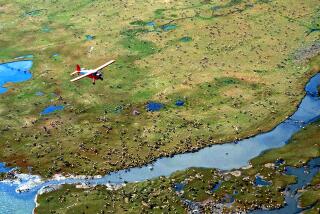Coalitions sue Forest Service to block Alaska old-growth timber sale
Reporting from SEATTLE — Two coalitions of environmental groups have filed three separate suits against the U.S. Forest Service, hoping to stop what the organizations say is the largest sale of old-growth timber in nearly a generation in America’s largest national forest.
Last week the Forest Service gave the final go-ahead for the so-called Big Thorne timber sale in Alaska’s Tongass National Forest, a scenic expanse the size of Delaware studded with 1,000-year-old trees. Under the terms of the multiyear sale, about 6,000 acres of old-growth trees would be harvested.
The Southeast Alaska Conservation Council is part of the coalition that filed suit Friday. The groups argue that the proposed Big Thorne timber sale “is taking a step backward toward the logging regime of old, where there is a high volume of old-growth forest slated to be cut,” council spokesman Daven Hafey said.
In addition, Hafey said, the Tongass has a so-called 50% export rule, which means that up to half of the timber cut can be exported as unprocessed “round logs.” The result is “removing the ability for locals to process that wood,” he said. “The Big Thorne will export long-term jobs for short-term profit.”
Advocates call the Tongass the largest intact old-growth temperate rain forest in the world. Although earlier logging practices clear-cut large swaths of the forest to produce pulp for making paper, that style of logging has been in transition. Only one mid-size mill and several mom-and-pop operations remain in the region.
The 17-million-acre national forest is in Alaska’s panhandle, the southeast portion of the state abutting British Columbia. It includes Prince of Wales Island, crucial habitat for the Alexander Archipelago wolf, which is being considered for Endangered Species Act listing, and the Sitka blacktailed deer, a major food source for many Alaskans in the region.
In addition to economic concerns, coalition members said, the Big Thorne sale also threatens a crucial ecosystem that supports the wolf, the deer and subsistence hunters and depends on the remaining old-growth forest.
Officials in the Forest Service’s Alaska regional office declined to comment on the lawsuit, one of two actions the first coalition filed Friday. Instead, the agency referred calls to the Justice Department in Washington. A department spokesman did not respond to a request for comment, nor did the owners of Viking Lumber Co., the remaining sizable mill in the region.
About 95% of the land in southeast Alaska is federally owned, said Owen Graham, executive director of the Alaska Forest Assn., a timber industry trade group. The Forest Service makes the resources on that land available for sale to private businesses. In this case, Graham said, the minimum bid for the Big Thorne sale is $6.5 million, which goes to the federal government.
“We only have one mid-sized sawmill left in operation in southeast Alaska. All the other mills have been starved out of business for lack of timber supply,” Graham said. “There just is no other significant source of timber than the Forest Service.... Our last sawmill doesn’t have enough wood to last through until there’s another sale. That’s why we need it so badly.”
The second lawsuit takes aim at the Forest Service’s Tongass Land Management Plan, Hafey said, arguing that it fails to protect deer habitat and deer hunting in the national forest and goes against the agency’s own analysis that the cumulative effects of high-volume timber sales hurt deer habitat and restrict deer hunting on public land.
The groups want a judge to rule that the Forest Service violated its mandate and to stop high-volume, export-oriented timber sales, Hafey said.
“Continuing a practice of clear-cutting thousands of acres of old-growth forests is a wasteful and unsustainable practice,” said Holly Harris, an attorney for Earthjustice, a nonprofit environmental law firm representing the first coalition. “The Tongass is a national treasure. It is an economic powerhouse for southeast Alaska because of sustainable industries like fishing and tourism.”
On Tuesday, a separate group of environmental organizations filed a third suit against the Forest Service seeking to stop the Big Thorne project.
This group, which includes Cascadia Wildlands and Greenpeace, said that the Alexander Archipelago wolf population on Prince of Wales Island had dropped sharply and that the federal agency ignored research by the foremost expert on the wolves in deciding to go forward with the sale.
“Without enough old-growth winter habitat in the forest for shelter, deer populations plummet during deep-snow winters,” said Gabriel Scott, Cascadia Wildlands’ Alaska legal director. “And without enough deer to go around, wolves and hunters are direct competitors.
“That never ends well for the wolf, or for hunters, because deer are the wolves’ primary prey,” Scott said. “Big Thorne bites hard into necessary winter habitat.”
Twitter: @marialaganga
More to Read
Sign up for Essential California
The most important California stories and recommendations in your inbox every morning.
You may occasionally receive promotional content from the Los Angeles Times.











